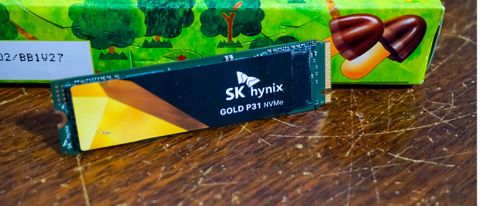TechRadar Verdict
The SK Hynix Gold P31 goes above and beyond in performance compared to many of its competitors, but new PCIe 4.0 SSDs are starting to enter the same market space with much better speeds and fair prices.
Pros
- +
Fast for PCIe 3.0
- +
Strong value
- +
Random strength
Cons
- -
Few capacities
- -
Dull looks
Why you can trust TechRadar
This is the system we used to test the SK Hynix Gold P31
CPU: AMD Ryzen 5 3600X
CPU Cooler: AMD Wraith Spire
RAM: 32GB T-Force Vulcan Z CL18 @3,600MHz
Motherboard: MSI B550 Pro VDH Wi-Fi
Graphics card: EVGA GeForce RTX 2070 XC Gaming
OS SSD: Samsung 980 Pro @ 500GB
Power Supply: Thermaltake Toughpower GF1 750W
Case: ThermalTake Core V21
The SK Hynix Gold P31 SSD has something special going for it: SK Hynix makes the very NAND flash that goes into the best SSDs, so it gets the latest tech – 128-layer 4D TLC NAND flash memory. SK Hynix also pairs that with its own controller and DRAM, so it should see its components working together effectively, and that certainly seems to be what the benchmarks indicate.
The SK Hynix Gold P31 may not be the fastest SSD, as it’s still using the PCIe 3.0 interface while the market is seeing more and more PCIe 4.0 options, but it’s one of the fastest PCIe 3.0 SSDs we’ve tested, and an impressive value.
The SK Hynix Gold P31 comes in at $135 (about £100, AU$175) for a 1TB model, however this is down from its original $224 (about £165, AU$295) price. That puts it in tight competition with old standbys like the $160 Samsung 970 Evo Plus and $140 WD Black SN750 as well as the $115 Corsair MP400. However, only the Corsair MP400 offers a more compelling price-per-gigabyte value, and none of the drives match the SK Hynix Gold P31 for speed.
Here’s how the SK Hynix Gold P31 performed in our suite of benchmark tests:
CrystalDiskMark Sequential: 3,602.05MB/s (read); 3,432.28MB/s (write)
CrystalDiskMark Random Q32: 2,442.2MB/s (read); 2,657.3MB/s (write)
10GB file transfer: 4.53 seconds
10GB folder transfer: 5.3 seconds
PCMark10 SSD: 2,296 points

The P31 steps well above the competition in terms of raw speed using the PCIe 3.0 x4 interface. We see it hit 3,602MB/s sequential read speeds that edge out former speed champions like the Samsung 970 Evo, 970 Pro, and WD Black SN750. The sequential write speeds give it an even stronger lead at 3,432MB/s, which outpaces all three of those competitors by over 400MB/s. Only the Corsair MP400 comes within striking distance of the P31’s speeds in our recent testing, but it still falls short by over 100MB/s in either test.
The P31 furthers its lead when it comes to random performance, which will likely be more important for your everyday needs. With random read speeds of 2,442MB/s and random write speeds of 2657MB/s, it’s a closer match to PCIe 4.0 SSDs than it is to the 300-400MB/s speeds of the Samsung 970 and WD Black SN750 families of products. In fact, it outpaced the PCIe 4.0 Silicon Power US70 in random write speed, though it can’t compete with sequential read/write performance.
As long as the current pricing of the SK Hynix Gold P31 holds, it’s an easy product to recommend, especially for laptop upgrades, where it’s single-sided PCB design should make it an easier fit and it’s green PCB won’t be an eyesore. The Corsair MP400 offers strong competition, and is a better bet for capacity since the P31 tops out at 1TB. But, the P31 has more speed and a much higher endurance at 750TBW (compared to the MP400’s 400TBW) while only costing slightly more.

Buy it if…
You want speed
If you’re trying to make the most of your PCIe 3.0 x4 slot, then the SK Hynix Gold P31 is a winner. You won’t get much faster speeds without moving to PCIe 4.0, and that’ll require a more expensive drive and maybe a new motherboard.
You have value on your mind
Speed is great, but it’s even better when it comes at a fair price. The P31 offers that with a strong dollar-per-gigabyte ratio that’s competitive with even QLC-based SSDs.
You’re upgrading your laptop’s storage
The design of the SK Hynix Gold P31 packs all the memory onto one side of the PCB, making it a slim drive that may have an easier time fitting into the tighter confines of a laptop than some other two-sided designs.
Don’t buy it if…
You’re decking out your gaming rig
Sure, the P31 would perform well in a gaming rig, but if you like to show off your components, you probably won’t like the plain green PCB of this SSD. And, since you probably don’t have a green motherboard, it’ll stick out.
You want maximum capacity
The P31 is good for speed and value, but SK Hynix doesn’t offer anything above 1TB. The Corsair MP400 may be a better choice there since you can find it in 2TB/4TB/8TB capacities that’ll make the most of your PCIe slots.
You’ve got PCIe 4.0 slots
The P31 is very good for a PCIe 3.0-based drive, but the latest generation of PCIe offers a leap in speeds, and the Silicon Power US70 costs only a little more for a serious upgrade.
Over the last several years, Mark has been tasked as a writer, an editor, and a manager, interacting with published content from all angles. He is intimately familiar with the editorial process from the inception of an article idea, through the iterative process, past publishing, and down the road into performance analysis.


